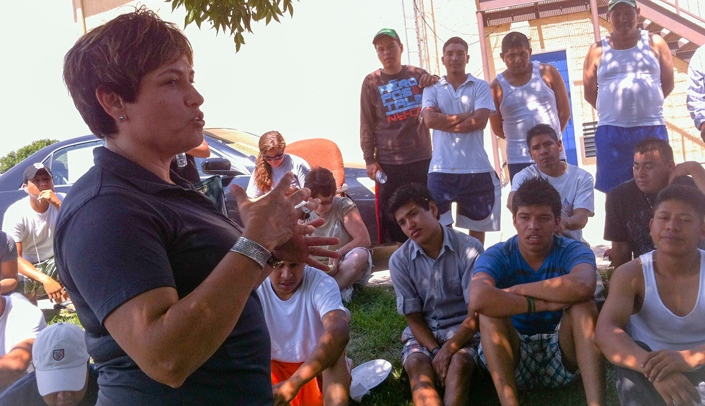Athena Ramos, program coordinator in the College of Public Health’s Center for Reducing Health Disparities, and her team spent last summer surveying 200 migrant workers in five counties in Nebraska.
Her goal: To develop baseline data on the health of migrant farmworkers and to understand their migratory patterns.
“No one really knows how many migrant workers there are in Nebraska,” said Ramos. In 1993, the National Center for Farmworker Health estimated there were 12,697 migrant workers in the state.
 |
Athena Ramos |
Portrait of a population
An average migrant farmworker is male, 33 years old and, if lucky, has a seventh grade education. He earns less than $12,500 for six months of backbreaking seasonal work and two months of nonagricultural work to support a family in his home country. He spends two months on the road and is unemployed for 10 weeks. An average family income is less than $17,500 – far below the United States poverty level of $23,550 for a family of four.
An estimated three to five million migrant and seasonal farmworkers are employed in this country each year. Their labor supports a $28 billion fruit and vegetable industry in the U.S. Latinos make up 83 percent of the migrant labor force.
Today, that many people in one place would constitute Nebraska’s 15th largest city — yet migrants are the most economically disadvantaged working group in the United States.
“Mobility and long days often threaten their health and pose a significant barrier to accessing health care,” Ramos said. Follow-up care and continuity of care for chronic conditions are serious problems.
Depression and stress are related to isolation, economic hardship, substandard and overcrowded living conditions, lack of recreation, physical, emotional and/or sexual abuse and weather conditions.
“Migrant workers are vulnerable and because of the challenging life conditions, low levels of education, and lack of access to culturally and linguistically appropriate health care services, they may be more at risk for injury and occupational exposures, substance abuse, and sexually transmitted diseases.
“What’s worse is there is a lack of general knowledge of preventive health care measures,” she said.
With the help of the Nebraska Migrant Education Program, Ramos and her team hosted dinners and community meetings in migrant camps (mostly low-end motels) in Hastings, Grand Island, O’Neill, Wood River, South Sioux City, Dakota, Kearney and Clay Center. They also distributed a bilingual resource guide on alcohol, tobacco, mental health and stress, with referrals to community health centers and relevant hotlines.
Ramos found two basic groups of workers — those who have an H2A visa come directly from Mexico, work for one employer for six to 10 weeks and then return to Mexico, and those who follow the crops through the Midwest. Major sources of stress were: legal and logistics, social isolation, work conditions, family, and substance abuse by others.
In addition to publishing journal reports, Ramos will share her results with state agencies and community stakeholders to open a dialogue and develop recommendations to improve living and working conditions for these workers.
“We need to conduct a larger study and develop interventions. This was just the first step. I’m dedicated to improving the life of migrant workers.”

Good story. This hits close to home.